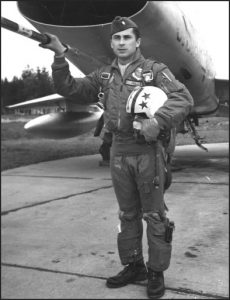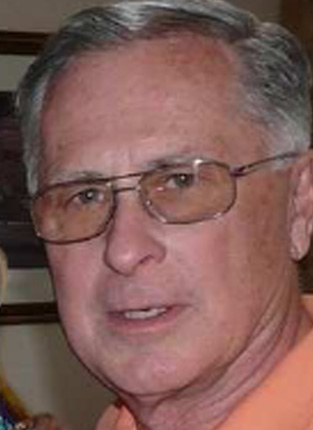After receiving his commission from ROTC in 1959, John spent 24 years in the Air force flying F-100’s, F-4’s and F-15’s. He was stationed in Europe for three tours and nine years during the Cold War sitting nuclear and air defense alert; was an early F-4 Instructor Pilot and later flew the phantom for 200 missions in Vietnam; commanded an F-4 test squadron, and was the vice commander of an F-15 unit.
John served in a variety of staff positions: Fighter Assignments at Air Force Military Personnel Center, Wing Chief of Stan Eval, USAFE command briefing officer and Chief of the Fighter Operations Division, TAC Chief of Personnel Programs, and Tactical Air Warfare Center Chief of Staff.
In 1985 he joined Lockheed’s Skunk Work where he began his association with the Advance Tactical Fighter program and the F-22. He was primarily involved in the test operations of Lockheed’s full mission simulators used to conduct developmental cockpit, avionics, and systems effectiveness design studies.
He finished his tour with Lockheed as the F-22 Combined Test Force cockpit engineer at Edwards AFB. He then spent five years as a consultant for SAIC supporting the Air Force’s operational open-air and simulator testing of the Raptor.
John and his wife are retired in Tucson, Arizona where he does aviation sculpture and volunteers at the Pima Air and Space Museum.
John “Cappy” Miller – Caterpillar Story
 It’s been said that for every 1000 hours in the Hun, the average jock will have to punch out once. My time came on a winter day in Germany during the early ’60s. Not surprising, Hahn had been socked in below minimums for nearly a week. Each day, a few of us in the 81st were chauffeured down to fly our aircraft stranded at Ramstein. After an early get-up and a two-plus hour staff car ride, I led a hi- low-hi “Low Level” mission. We eventually found some VFR weather between Paris and the channel coast to complete the IP to target leg of the profile. On the way back, above the cloud deck and over Etain, I had a generator failure. The constant speed drive froze up and the generator drive shaft sheared as planned.
It’s been said that for every 1000 hours in the Hun, the average jock will have to punch out once. My time came on a winter day in Germany during the early ’60s. Not surprising, Hahn had been socked in below minimums for nearly a week. Each day, a few of us in the 81st were chauffeured down to fly our aircraft stranded at Ramstein. After an early get-up and a two-plus hour staff car ride, I led a hi- low-hi “Low Level” mission. We eventually found some VFR weather between Paris and the channel coast to complete the IP to target leg of the profile. On the way back, above the cloud deck and over Etain, I had a generator failure. The constant speed drive froze up and the generator drive shaft sheared as planned.
Everything close by was below minimums. Ramstein was the closest good weather base at 500 & 2. I declared an emergency, shut off what I could, and started a slow descent toward Ramstein. It didn’t take long for things to get ugly. The radio and the warning lights started petering out. When I no longer could hear the radar vectors to the base, I gave the lead to my wingman. As soon as I touched the throttle to follow him, the engine flamed out. I tried a restart, then another, then another. I kept this up while I headed for a dark spot in the undercast that suggested a break in the clouds.
My wingman rejoined and I waved a bunch of hand signals to indicate no engine, no electrics, and no radio. I eased down through some small gaps in clouds trying more restarts. I started seeing patches of forested hills beneath me. When the warning lights finally dimmed out, I pulled up on the handles to jettison the canopy and indicate an imminent ejection. I cinched down on the parachute straps and tossed my checklist clipboard over the side (returned to me a year later by a woman who found it in her garden). I could now see more of the ground.
When I crossed over a few small farm fields, I pushed back in the seat, shut my eyes and pulled the trigger. I felt an upward surge. My eyelids must have been forced open by the acceleration as I remember an instantaneous blurry image of a black hole and gray shape of the aircraft (pre-camouflage days) fading away beneath my feet. I tried to push away from the seat, but the butt-kicker already ensured separation. After a few violent somersaults, I heard the chute deploying and felt the jerk of the opening. I had a couple of small rips in the canopy. I was probably a couple of thousand feet above the ground. I pulled the survival kit lanyard outward like the book said, but nothing happened. I continued to yank on the lanyard without success. I remembered the stories of broken legs as the result of landing with the kit still attached. I tried to reach down with one hand to disconnect the survival kit, but couldn’t open the latch and pull the hook over the harness D-ring. I had cinched the kit straps too damn tight. I had drifted from the farm fields and was now racing down towards a wooded hilltop.
I noticed a particularly big oak beneath my feet with huge, ugly, leafless branches reaching upward. I pulled down on various risers as I spiraled down, attempting to change my flight path. This was before we knew about cutting lines to improve controllability. The big oak was getting bigger very fast and it was clear I was aimed right at it. I closed my arms in front of my chest and face, held my legs together as tight as I could and pointed my toes as if it would ease my way into the maze of branches. I came down through the top of the oak making lots of crashing sounds.
Actually, the survival kit did a pretty good job of protecting my behind. I made it out through the bottom of the branches, bounced once as the canopy caught, and then fell to the ground as it pulled free. I ended up dropping about two feet and landed sitting, ever so nicely, on the survival kit. I got out my survival radio and, as my wingman crossed over the oak and me, told him I was okay and to send transportation. I packed up the chute and survival kit and started down the hillside.
Four German guys had seen me floating down and were coming up the hill looking for me. They somehow managed to get the five of us plus all my gear into a VW bug and we headed for a nearby town. We arrived at the local Gasthaus where I was administered brandy by the owner, he must have been a flight surgeon at one time in his life. In between several additional rounds of medicinal spirits, I was able to call Ramstein and file an initial report with our Flying Safety officer. He had driven down with us that morning and was flight planning at Base Ops for a cushy cross-country trip to Madrid, which he never quite made. Some Army MP’s arrived to take me to a Huey waiting at the edge of town. We delayed the trip back to Ramstein for a bit to look for the wreckage of F-100D 563206. The Army Huey pilots zigzagged around the hills, in and out of low clouds and fog, scaring the hell out of me until we were instructed to get me back to the base hospital. The flight surgeons took blood samples and x-rays to ensure I was all right. Of course, I wondered if the accident board would use my blood alcohol level as a contributing cause of the accident.
I ended up back at our sister squadron just as the 17th Air Force commander stopped by to determine, “what the hell I had done with his airplane.” He wasn’t all that happy as he also lost an F-105 and had a T-33 limp back after multiple flameouts; all had taken off from Ramstein. It was another two-plus hours in the staff car climbing back up to Flugplatz Hahn. I ended up on backup Victor alert that night so others could search the woods between Bit and Spang for Blake Morrison, the Thud driver. Blake wasn’t as fortunate. His chute collapsed coming through the tall pines and he crushed his spine during the drop to the ground. He survived 30 plus hours during a snowstorm before being found. I was lucky. Like so many other young lieutenants, God must have taken pity on me, figuring I was still too green and had so much more to learn. He was sure right about that.
-Cappy Miller









